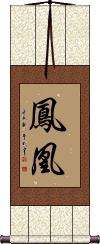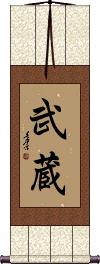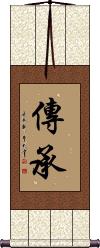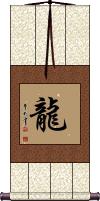Many custom options...
And formats...

Legend in Chinese / Japanese...
Buy a Legend calligraphy wall scroll here!
Personalize your custom “Legend” project by clicking the button next to your favorite “Legend” title below...
Legendary Phoenix
鳳凰 is the word that translates as “Legendary Phoenix” in Chinese.
This refers to the bird that, according to Chinese folklore, rose from the fiery ashes.
The phoenix and dragon are by far the most famous creatures in Chinese mythology.
Musashi
The most famous Samurai
Miyamoto Musashi is probably the most famous Samurai in all of Japanese history.
武蔵 is the short title for a man long in legend. While coming from a lower class, his new sword and fighting techniques put him on par with the best that feudal Japan had to offer. His long career started with his first duel at age 13!
He is credited with using two swords at once and never losing a single battle in his career. After becoming a Buddhist, and getting older, like many old warriors, he took up a peaceful and solitary life until his death around 1645 A.D.
Note: Technically, Musashi is his given name, and Miyamoto is his surname. However, it's suggested that he assumed both of these names and had a few other names in childhood, as well as being given a Buddhist name. It's hard to know what to call him, as with most Kanji, there are multiple pronunciations. The characters for Musashi can also be pronounced Takezō. But everyone in modern times seems to know him by the name Musashi.
Arata
Smriti
傳承 is a Chinese and Japanese word that means to pass on (to future generations).
This can also mean passed on (from former times), a continued tradition, handing down (information), legend, tradition, folklore, transmission, or an inheritance.
傳承 is the Chinese equivalent of Smriti (from Sanskrit: स्मृति / Smṛti). The term can be used for Hindu (and sometimes Buddhist) texts that have authority because the author is known.
Phoenix Rise from the Ashes
鳳凰涅磐 is a proverb that suggests “Legendary Phoenix rises from the ashes.” It means “Legendary Phoenix [reaches] Nirvana.”
There is a legend in China of a great bird reborn once every 500 years. This bird gathers all the ill will, suffering, desire, and other negative things of the world. The bird then plunges into the fire to burn away all negative things, sacrificing itself in the process (achieving Nirvana, or perhaps allowing others the opportunity to reach Nirvana).
500 years later, the phoenix is reborn from the ashes again, and the cycle repeats.
Dragon
Year of the Dragon / Zodiac Sign
龍 is the character for dragon in Chinese, old Korean Hanja, and Japanese Kanji.
The dragon is a creature of myth and legend that dominates Chinese, Japanese, and even European folklore. In China, the dragon is the symbol of the Emperor, strength, and power, and the Chinese dragon is known as the god of water.
From the Chinese Zodiac, if you were born in the year of the Dragon, you . . .
Have a strong body and spirit.
Are full of energy.
Have vast goals.
Have a deep level of self-awareness.
Will do whatever you can to “save face.”
See also our Chinese Zodiac or Dragon Calligraphy pages.
Ultimate Loyalty to Your Country
The most famous tattoo in Chinese history
盡忠報國 is a proverb that is the tattoo worn on the back of Yue Fei, a famous Chinese warrior who lived until 1142 A.D.
The tattoo can be translated as “Serve the country with the utmost loyalty.” More literally, it means “[The] Ultimate Loyalty [is too] Duty [of] Country.”
Legend has it that this tattoo once saved his life when he was accused of treason.
The first two characters have come to create a word that means “serve the country faithfully” or “die for the country.” Note: It's more a willingness to die for one's country than the actual act of dying.
The last two characters have come to mean “Dedicate oneself to the service of one's country.”
Both of these words are probably only in the Chinese lexicon because of this famous tattoo.
If you break it down, character-by-character, here is what you get:
1. To the utmost, to the limit of something, the ultimate.
2. Loyalty or duty (a sense of duty to one's master, lord, country, or job).
3. Report, recompense, give back to (in this case, you are giving yourself to your country as payback).
4. Country, state, nation, kingdom.
Not the results for legend that you were looking for?
Below are some entries from our dictionary that may match your legend search...
| Characters If shown, 2nd row is Simp. Chinese |
Pronunciation Romanization |
Simple Dictionary Definition |
伝 see styles |
chuán chuan2 ch`uan chuan den でん |
Japanese variant of 傳|传 (1) legend; tradition; (2) biography; life; (3) method; way; (4) horseback transportation and communication relay system used in ancient Japan; (surname) Fu |
讚 赞 see styles |
zàn zan4 tsan san さん |
variant of 贊|赞[zan4]; to praise a style of Chinese poetry; legend or inscription on a picture stotra, hymn, praise. |
井河 see styles |
jǐng hé jing3 he2 ching ho igawa いがわ |
(surname) Igawa Like the well and the river', indicating the impermanence of life. The 'well ' refers to the legend of the man who running away from a mad elephant fell into a well; the 'river ' to a great tree growing on the river bank yet blown over by the wind. |
伝え see styles |
tsutae つたえ |
legend; tradition |
伝承 see styles |
denshou / densho でんしょう |
(n,vs,adj-no) handing down (information); legend; tradition; folklore; transmission |
伝説 see styles |
densetsu でんせつ |
(noun - becomes adjective with の) legend; folklore; tradition |
傳說 传说 see styles |
chuán shuō chuan2 shuo1 ch`uan shuo chuan shuo densetsu |
legend; folk tale; to repeat from mouth to mouth; they say that... a transmitter |
再話 see styles |
saiwa さいわ |
(noun, transitive verb) retelling (of a tale, legend, etc.) |
凡例 see styles |
fán lì fan2 li4 fan li hanrei / hanre はんれい |
notes on the use of a book; guide to the reader (1) explanatory notes (at the start of a book); introductory remarks; usage guide (e.g. of a dictionary); (2) (See キャプション・1) legend (on maps, drawings, etc.) |
口碑 see styles |
kǒu bēi kou3 bei1 k`ou pei kou pei kouhi / kohi こうひ |
public praise; public reputation; commonly held opinions; current idiom oral tradition; legend; folklore |
古事 see styles |
koji こじ |
(1) historical event; ancient event; (2) tradition; folklore; legend; origin |
古伝 see styles |
koden こでん |
legend; tradition |
名宿 see styles |
míng sù ming2 su4 ming su |
renowned senior figure; luminary; legend (in academia, sport etc) |
圖例 图例 see styles |
tú lì tu2 li4 t`u li tu li |
legend (of a map, etc); diagram; illustration; graphical symbol |
故事 see styles |
gù shi gu4 shi5 ku shih koji こじ |
narrative; story; tale (1) historical event; ancient event; (2) tradition; folklore; legend; origin |
昔話 see styles |
mukashibanashi むかしばなし |
(1) old tale; folk tale; legend; (2) reminiscence |
杖林 see styles |
zhàng lín zhang4 lin2 chang lin Jōrin |
Yaṣṭivana, 洩瑟知林; the forest in which a Brahman tried to measure Buddha's height with a 16 ft. bamboo pole, but the more he measured the higher the body became; another part of the legend is that the forest grew from the bamboo which he left behind in chagrin. |
爛柯 see styles |
ranka らんか |
(1) (form) (See 囲碁) go (board game); (2) (from a Chinese legend about a man who watches a game of go for so long that the handle of his axe rots away) being so engrossed in go that one loses track of time; being so engrossed in an activity that one loses track of time |
物語 物语 see styles |
wù yǔ wu4 yu3 wu yü monogatari ものがたり |
monogatari; epic narrative (Japanese literary form) (n,vs,adj-no) tale; story; legend |
甘蔗 see styles |
gān zhe gan1 zhe5 kan che kansho; kansha かんしょ; かんしゃ |
sugar cane; CL:節|节[jie2] sugar cane; (surname) Kansho Sugar-cane, symbol of many things. A tr. of Ikṣvāku, one of the surnames of Śākyamuni, from a legend that one of his ancestors was born from a sugar-cane. |
画讃 see styles |
gasan がさん |
legend over a picture; inscription (legend, writing) on a painting |
画讚 see styles |
gasan がさん |
(out-dated kanji) legend over a picture; inscription (legend, writing) on a painting |
画賛 see styles |
gasan がさん |
legend over a picture; inscription (legend, writing) on a painting |
相傳 相传 see styles |
xiāng chuán xiang1 chuan2 hsiang ch`uan hsiang chuan sōden |
to pass on; to hand down; tradition has it that ...; according to legend transmission of the Way from master to disciple |
神話 神话 see styles |
shén huà shen2 hua4 shen hua shinwa しんわ |
legend; fairy tale; myth; mythology (noun - becomes adjective with の) myth; legend; (female given name) Kamiwa |
説明 see styles |
setsumei / setsume せつめい |
(noun, transitive verb) explanation; exposition; description; account; caption; legend |
イース see styles |
iisu / isu イース |
(1) (place) Ys (mythical city in Brittany); (2) (product) Ys (series of games based loosely on the same legend); Eythe; (personal name) Eads |
不周山 see styles |
bù zhōu shān bu4 zhou1 shan1 pu chou shan |
Buzhou Mountain, a mountain from Chinese legend |
伝え話 see styles |
tsutaebanashi つたえばなし |
legend |
優曇華 优昙华 see styles |
yōu tán huā you1 tan2 hua1 yu t`an hua yu tan hua udonge うどんげ |
(1) udumbara (mythical Indian plant often identified with the cluster fig, Ficus glomerata); (2) something very rare (from the legend that the udumbara flowers once in 3000 years); (3) (See バショウ) Japanese fiber banana flower; (4) (See クサカゲロウ) green lacewing eggs; (female given name) Yūka udumbara flower |
Click here for more legend results from our dictionary
The following table may be helpful for those studying Chinese or Japanese...
| Title | Characters | Romaji (Romanized Japanese) | Various forms of Romanized Chinese | |
| Legendary Phoenix | 鳳凰 凤凰 | houou / ho | fèng huáng feng4 huang2 feng huang fenghuang | |
| Musashi | 武蔵 | mu sashi / musashi | ||
| Arata | アラタ | arata | ||
| Smriti | 傳承 传承 | denshou / densho | chuán chéng chuan2 cheng2 chuan cheng chuancheng | ch`uan ch`eng chuancheng chuan cheng |
| Phoenix Rise from the Ashes | 鳳凰涅磐 凤凰涅磐 | fèng huáng niè pán feng4 huang2 nie4 pan2 feng huang nie pan fenghuangniepan | feng huang nieh p`an fenghuangniehpan feng huang nieh pan |
|
| Dragon | 龍 龙 | ryuu / tatsu ryu / tatsu | lóng / long2 / long | lung |
| Ultimate Loyalty to Your Country | 盡忠報國 尽忠报国 | jìn zhōng bào guó jin4 zhong1 bao4 guo2 jin zhong bao guo jinzhongbaoguo | chin chung pao kuo chinchungpaokuo |
|
| In some entries above you will see that characters have different versions above and below a line. In these cases, the characters above the line are Traditional Chinese, while the ones below are Simplified Chinese. | ||||
Successful Chinese Character and Japanese Kanji calligraphy searches within the last few hours...










